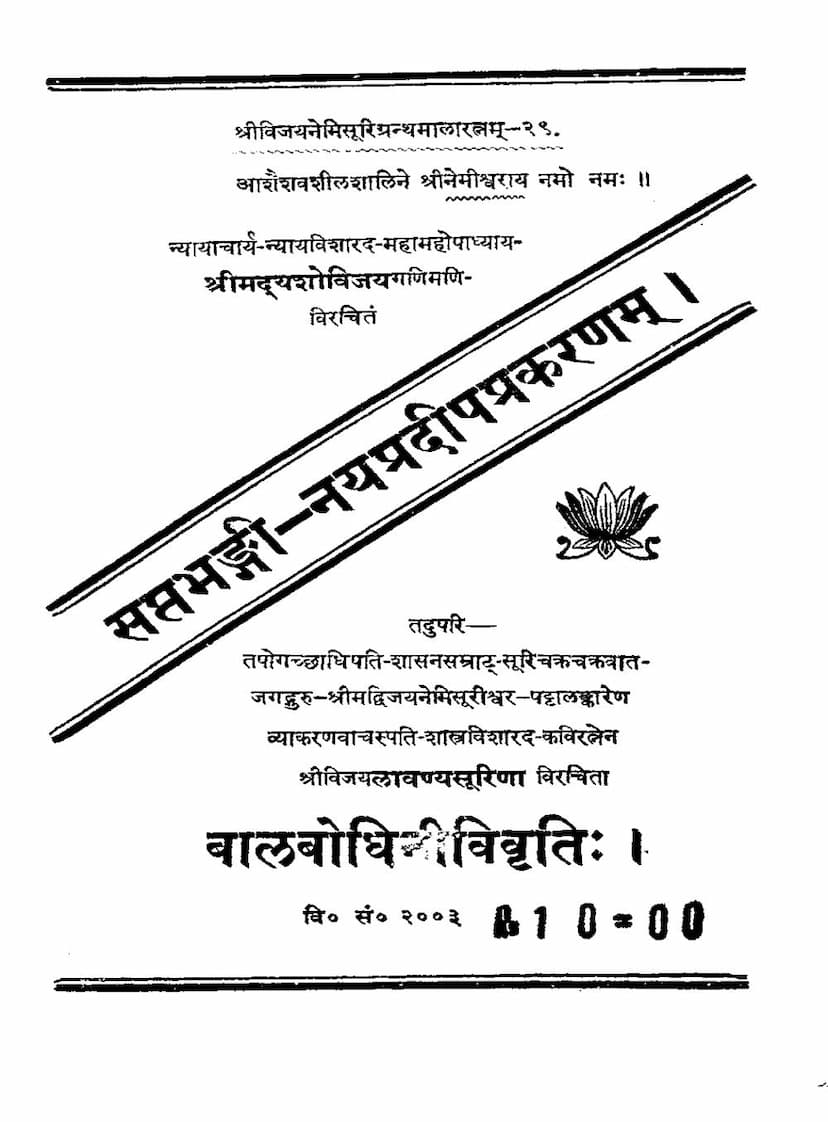Saptabhangi Naypradipa Prakarana
Added to library: September 2, 2025

Summary
This Jain text, "Saptabhangi Naypradipa Prakarana" by Yashovijay Upadhyay and Lavanyasuri, is a profound exploration of the Jain doctrine of Syadvada (the doctrine of conditional predication) and the various Nayas (standpoints or ways of speaking).
Core Concepts:
-
Saptabhangi (Seven-fold Predication): The central theme is the Saptabhangi, which posits that any proposition about reality can be expressed in seven ways, acknowledging the multi-faceted nature of existence. These seven propositions, all prefixed with "Syat" (perhaps/maybe), are:
- Syad asti (It is, perhaps)
- Syad nasti (It is not, perhaps)
- Syad asti nasti (It is and it is not, perhaps)
- Syad avaktavyam (It is indescribable, perhaps)
- Syad asti avaktavyam (It is and it is indescribable, perhaps)
- Syad nasti avaktavyam (It is not and it is indescribable, perhaps)
- Syad asti nasti avaktavyam (It is, it is not, and it is indescribable, perhaps)
The text elaborates on how these seven propositions can be applied to understand a single entity from different perspectives, avoiding absolutist or one-sided views. It emphasizes that these are not contradictory but complementary ways of describing reality, each valid within its own context.
-
Nayas (Standpoints): The latter part of the text delves into the various Nayas (standpoints) used in Jain philosophy to understand and describe reality. The text categorizes and explains these Nayas, with a particular focus on:
- Dravyarthika Naya (Substantial Standpoint): This naya focuses on the substance or essence of things, their underlying reality that remains constant despite changes.
- Paryayarthika Naya (Modal Standpoint): This naya focuses on the modes, attributes, or transformations that occur in a substance.
The text further breaks down these major categories into sub-Nayas, such as:
- Dravyarthika Nayas: Naigama, Sangraha, Vyavahara, and their various classifications.
- Paryayarthika Nayas: Rujusutra, Shabda, Samabhirudha, and Evambhuta.
Each naya is defined, explained, and illustrated with examples, showing how different Nayas offer distinct but valid ways of apprehending reality. The text also discusses the concept of Nayaabhasas (fallacious standpoints) that arise from misinterpreting or misapplying these Nayas.
Structure and Content:
The book is a commentary, the "Balabodhini Vivriti," on the original work by Yashovijay Upadhyay. The commentary, authored by Lavanyasuri, aims to make the complex philosophical concepts accessible to a wider audience, particularly beginners.
- Introduction and Mangala (Invocation): The text begins with invocations (Mangala) to deities and spiritual preceptors, a common practice in Indian philosophical works to ensure the auspicious completion of the task.
- Explanation of Saptabhangi: The core of the book is the detailed explanation of each of the seven propositions of Syadvada, providing philosophical reasoning and demonstrating their application.
- Detailed Analysis of Nayas: The latter half offers an extensive analysis of various Nayas, their definitions, classifications, and interrelationships. This section is particularly rich in its exploration of the nuances of Jain logic and epistemology.
- Commentary by Lavanyasuri: The commentary (Balabodhini Vivriti) aims to simplify the original text, explaining difficult passages, clarifying concepts, and providing a lucid exposition for those seeking to understand these profound philosophical ideas.
Significance:
This work is a valuable resource for understanding the sophisticated logic and epistemological framework of Jainism. It highlights the Jain emphasis on avoiding dogmatism and embracing a comprehensive, multi-perspectival approach to understanding truth. The commentary makes these complex ideas more digestible, contributing to the propagation of Jain philosophical thought.